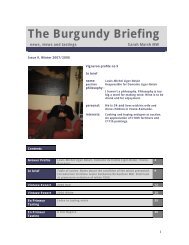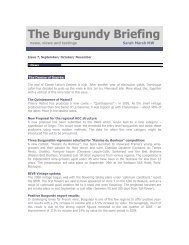En primeur tasting - Burgundy Briefing
En primeur tasting - Burgundy Briefing
En primeur tasting - Burgundy Briefing
Create successful ePaper yourself
Turn your PDF publications into a flip-book with our unique Google optimized e-Paper software.
Below the house is a 0.6 hectare parcel of 60-80 year old vines. The soil is only clay<br />
with no limestone.<br />
Light and perfumed, rather delicate and fruity. Rounded, raspberrish with vibrant<br />
acidity and fine, smooth tannins. Very good, very charming village wine. From 2007<br />
Vosne-Romanée, Clos Du Chateau<br />
35 years old vines on 0.83 hectares, which lie at the beginning of the slope where the<br />
soil is rich in limestone. It is a clos with 4 walls. Liger-Belair points out that the walls<br />
are an important part of the microclimate in a small parcel for of course the stone will<br />
absorb heat during the day and radiate it at night. This clos was originally the garden<br />
of the château, but 36 years ago his father planted it with vines. However if one goes<br />
back further still to 1850, it was a vineyard. (It is necessary for a clos to have three<br />
walls to qualify as such.)<br />
This wine is very bright and floral with juicy acidity and wonderfully pure redcurrant<br />
fruit with high notes of white pepper. A very feminine wine, intense and fragrant with<br />
taut chalky tannins, a reserved linear structure, good pace and lovely length. Top<br />
notch village. From 2008<br />
Vosne-Romanée, Les Chaumes<br />
This is a really tiny 50 year old parcel of 0.12 hectares, well placed just below La<br />
Tâche (top north/west position). It is made in a small wood vat for it only produces<br />
two barrels. Liger-Belair points out that it has a shorter fermentation than the other<br />
wine, just three to four days, and that in such a small volume it is of course more<br />
difficult to preserve the temperature. In previous vintages he has pressed the wine<br />
on top of Les Reignots, but he wasn’t happy with the results, so in 2004 he made a<br />
separate press.<br />
Red fruit and roses, very perfumed. Richer with a more tannic structure, a bigger<br />
framework, sweet fruit, bold but elegant with excellent extract, lovely acidity, really<br />
very fresh and juicy, a firm mineral core and a long, silky finish. A very well<br />
structured Les Chaumes. Fine. From 2008.<br />
Vosne-Romanée, Les Reignots<br />
1.61 hectares, so half of Les Reignots. The family have owned this since the C18 th. It<br />
is an unusual parcel as it runs from the top to the bottom of the appellation, giving a<br />
cross section of the terroir, which Liger-Belair considers important for quality. There<br />
is an average 20cm of earth before bedrock he tells me and he believes the roots may<br />
go down as far as 10 metres, particularly as in 2003 the vines here showed little sign<br />
of the drought. Two thirds of the vines are over 60 years old and the ground is very<br />
stony and hard to work, but Liger-Belair finds it a rewarding parcel, as it vividly<br />
repays all the work put into it. At the moment he is propagating a sélection massale<br />
from the old vines, to use instead of clones in the domaine. The vines selected are<br />
affected by millerandage and therefore yield low.<br />
Very dense and rich and incredibly intense. Minerally attack, tight and focused, Taut<br />
core, powerful, very precise with real drive. Profound fruit and excellent extract.<br />
Tense tannic structure and masses of uncoiled energy. Very long. Very fine+. I like<br />
this a great deal. From 2010.<br />
La Romanée<br />
0.8452 hectares. It pays to be precise at this level. This has been a monopole since<br />
1826. On paper the vines are 50 years old, but Liger-Belair thinks that in fact the









